
|
Astronomy Picture Of the Day (APOD)
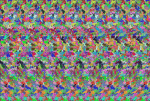 The Holographic Principle
The Holographic Principle
30.04.2002
Is this image worth a thousand words? According to the Holographic Principle, the most amount of information you can get from this image is about 3 x 1065 bits for a normal sized computer monitor.
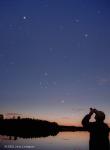 Dusk of the Planets
Dusk of the Planets
29.04.2002
A great grouping of planets is now visible to the west just after sunset. Over the next two weeks, Mercury, Venus, Earth, Mars, Jupiter, and Saturn -- all the planets of the inner Solar System -- can be seen in a single knowing glance. The image on the left captured them all in one frame.
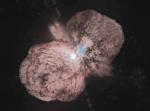 Doomed Star Eta Carinae
Doomed Star Eta Carinae
28.04.2002
Eta Carinae may be about to explode. But no one knows when - it may be next year, it may be one million years from now. Eta Carinae's mass - about 100 times greater than our Sun - makes it an excellent candidate for a full blown supernova.
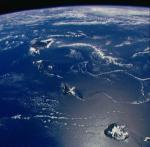 Hawaii
Hawaii
27.04.2002
Aloha! With the graceful arc of Earth's limb in the background, the Hawaiian Island archipelago is visible in this stunning photo taken by the astronauts onboard the shuttle Discovery in October of 1988. Along with popular beaches and tropical resorts, these volcanic islands offer extreme elevations with dark, dry, cloudless skies.
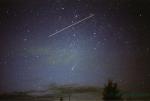 Comet Ikeya Zhang Meets The ISS
Comet Ikeya Zhang Meets The ISS
26.04.2002
Still catching the Sun's rays, the International Space Station (ISS) cruises across the early evening sky above Tomahawk, Wisconsin, USA. Recorded on April 9 around 9 pm CDT in a 30 second exposure, the sunlit space station traced this bright streak moving east (right) through the constellation Cassiopeia.
 Southern Cross in Mauna Loa Skies
Southern Cross in Mauna Loa Skies
25.04.2002
Gazing across this gorgeous skyscape, the Southern Cross and stars of the constellation Centaurus are seen above the outline of Mauna Loa (Long Mountain), planet Earth's largest volcano. Unfamiliar to sky gazers north...
 The Trifid Nebula from AAO
The Trifid Nebula from AAO
24.04.2002
Unspeakable beauty and unimaginable bedlam can be found together in the Trifid Nebula. Also known as M20, this photogenic nebula is visible with good binoculars towards the constellation of Sagittarius. The energetic processes of star formation create not only the colors but the chaos. The red-glowing gas results from high-energy starlight striking interstellar hydrogen gas.
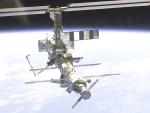 The Newly Expanded International Space Station
The Newly Expanded International Space Station
23.04.2002
What does the developing International Space Station (ISS) look like now? After delivering and deploying a crucial first backbone-like component last week, the Space Shuttle Atlantis took an inspection lap around the space station. The newly installed truss is visible toward the center of the above image.
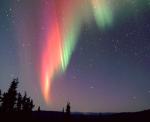 Comet and Aurora Over Alaska
Comet and Aurora Over Alaska
22.04.2002
Can you spot the comet? Flowing across the frozen Alaskan landscape is an easily visible, colorful aurora. Just to the lower left, however, well in the background, is something harder to spot: Comet Ikeya-Zhang, the brightest comet of recent years. Although the aurora faded in minutes, the comet is just now beginning to fade.
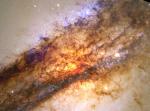 The Center of Centaurus A
The Center of Centaurus A
21.04.2002
A fantastic jumble of young blue star clusters, gigantic glowing gas clouds, and imposing dark dust lanes surrounds the central region of the active galaxy Centaurus A. This mosaic of Hubble Space Telescope images taken in blue, green, and red light has been processed to present a natural color picture of this cosmic maelstrom.
|
January February March April May June July August September October November December |
|||||||||||||||||||||||||||||||||||||||||||||||||